warning SSANGYONG MUSSO 2003 Service Manual
[x] Cancel search | Manufacturer: SSANGYONG, Model Year: 2003, Model line: MUSSO, Model: SSANGYONG MUSSO 2003Pages: 1574, PDF Size: 26.41 MB
Page 12 of 1574
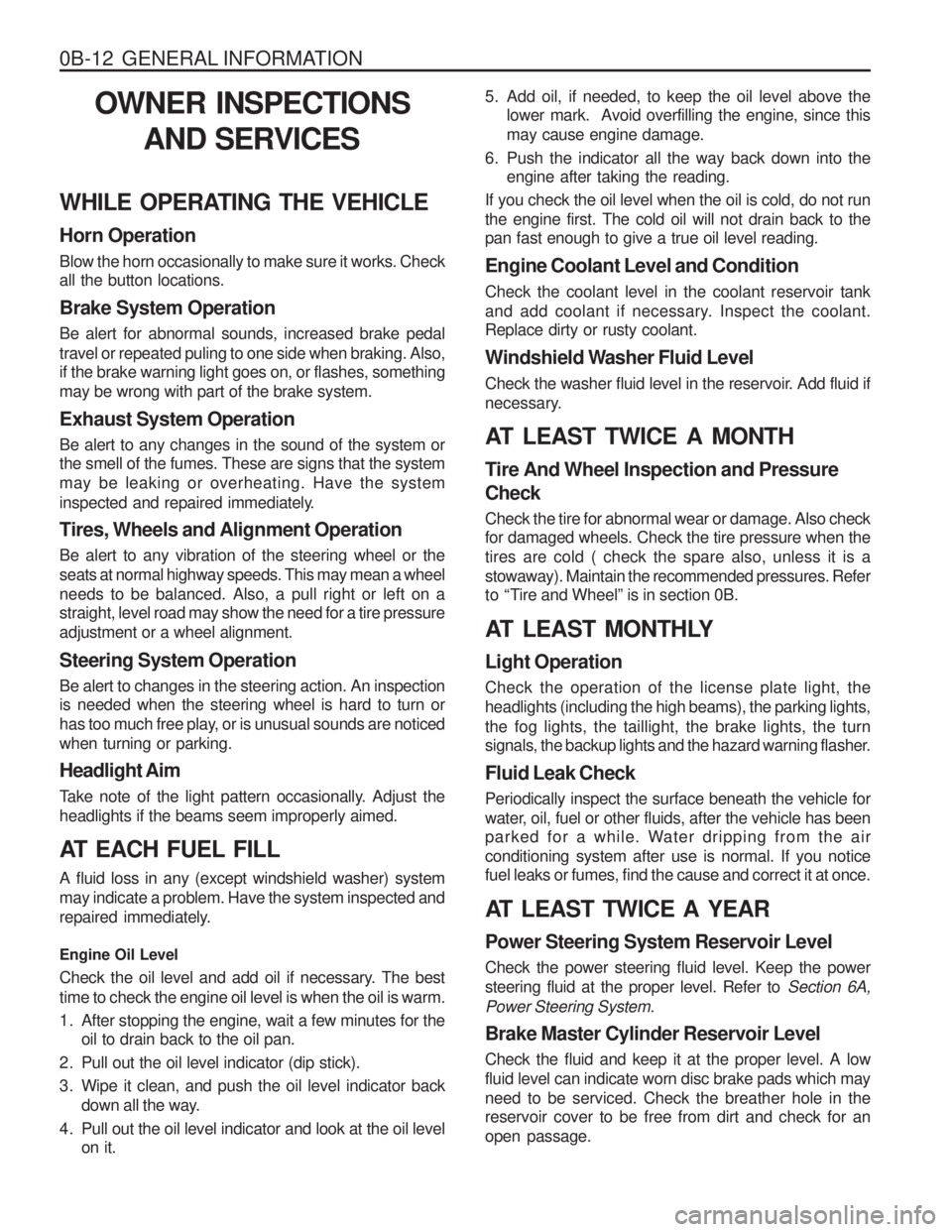
0B-12 GENERAL INFORMATIONOWNER INSPECTIONS AND SERVICES
WHILE OPERATING THE VEHICLE Horn Operation Blow the horn occasionally to make sure it works. Check all the button locations. Brake System Operation Be alert for abnormal sounds, increased brake pedal travel or repeated puling to one side when braking. Also, if the brake warning light goes on, or flashes, something may be wrong with part of the brake system. Exhaust System Operation Be alert to any changes in the sound of the system or the smell of the fumes. These are signs that the system may be leaking or overheating. Have the system
inspected and repaired immediately. Tires, Wheels and Alignment Operation Be alert to any vibration of the steering wheel or the seats at normal highway speeds. This may mean a wheelneeds to be balanced. Also, a pull right or left on a straight, level road may show the need for a tire pressure adjustment or a wheel alignment. Steering System Operation Be alert to changes in the steering action. An inspection is needed when the steering wheel is hard to turn or
has too much free play, or is unusual sounds are noticedwhen turning or parking. Headlight Aim
Take note of the light pattern occasionally. Adjust the headlights if the beams seem improperly aimed.
AT EACH FUEL FILL A fluid loss in any (except windshield washer) system may indicate a problem. Have the system inspected and
repaired immediately. Engine Oil Level
Check the oil level and add oil if necessary. The best time to check the engine oil level is when the oil is warm.
1. After stopping the engine, wait a few minutes for the oil to drain back to the oil pan.
2. Pull out the oil level indicator (dip stick).
3. Wipe it clean, and push the oil level indicator back down all the way.
4. Pull out the oil level indicator and look at the oil level on it. 5. Add oil, if needed, to keep the oil level above the
lower mark. Avoid overfilling the engine, since this may cause engine damage.
6. Push the indicator all the way back down into the engine after taking the reading.
If you check the oil level when the oil is cold, do not runthe engine first. The cold oil will not drain back to the pan fast enough to give a true oil level reading. Engine Coolant Level and Condition Check the coolant level in the coolant reservoir tank
and add coolant if necessary. Inspect the coolant. Replace dirty or rusty coolant.
Windshield Washer Fluid Level
Check the washer fluid level in the reservoir. Add fluid if
necessary.
AT LEAST TWICE A MONTH Tire And Wheel Inspection and Pressure Check Check the tire for abnormal wear or damage. Also check for damaged wheels. Check the tire pressure when the tires are cold ( check the spare also, unless it is astowaway). Maintain the recommended pressures. Refer
to “Tire and Wheel” is in section 0B.
AT LEAST MONTHLY Light Operation Check the operation of the license plate light, the headlights (including the high beams), the parking lights,the fog lights, the taillight, the brake lights, the turn
signals, the backup lights and the hazard warning flasher. Fluid Leak Check Periodically inspect the surface beneath the vehicle for
water, oil, fuel or other fluids, after the vehicle has been
parked for a while. Water dripping from the air conditioning system after use is normal. If you notice fuel leaks or fumes, find the cause and correct it at once.
AT LEAST TWICE A YEAR Power Steering System Reservoir Level Check the power steering fluid level. Keep the power steering fluid at the proper level. Refer to Section 6A,
Power Steering System. Brake Master Cylinder Reservoir Level Check the fluid and keep it at the proper level. A low fluid level can indicate worn disc brake pads which mayneed to be serviced. Check the breather hole in the reservoir cover to be free from dirt and check for an open passage.
Page 703 of 1574
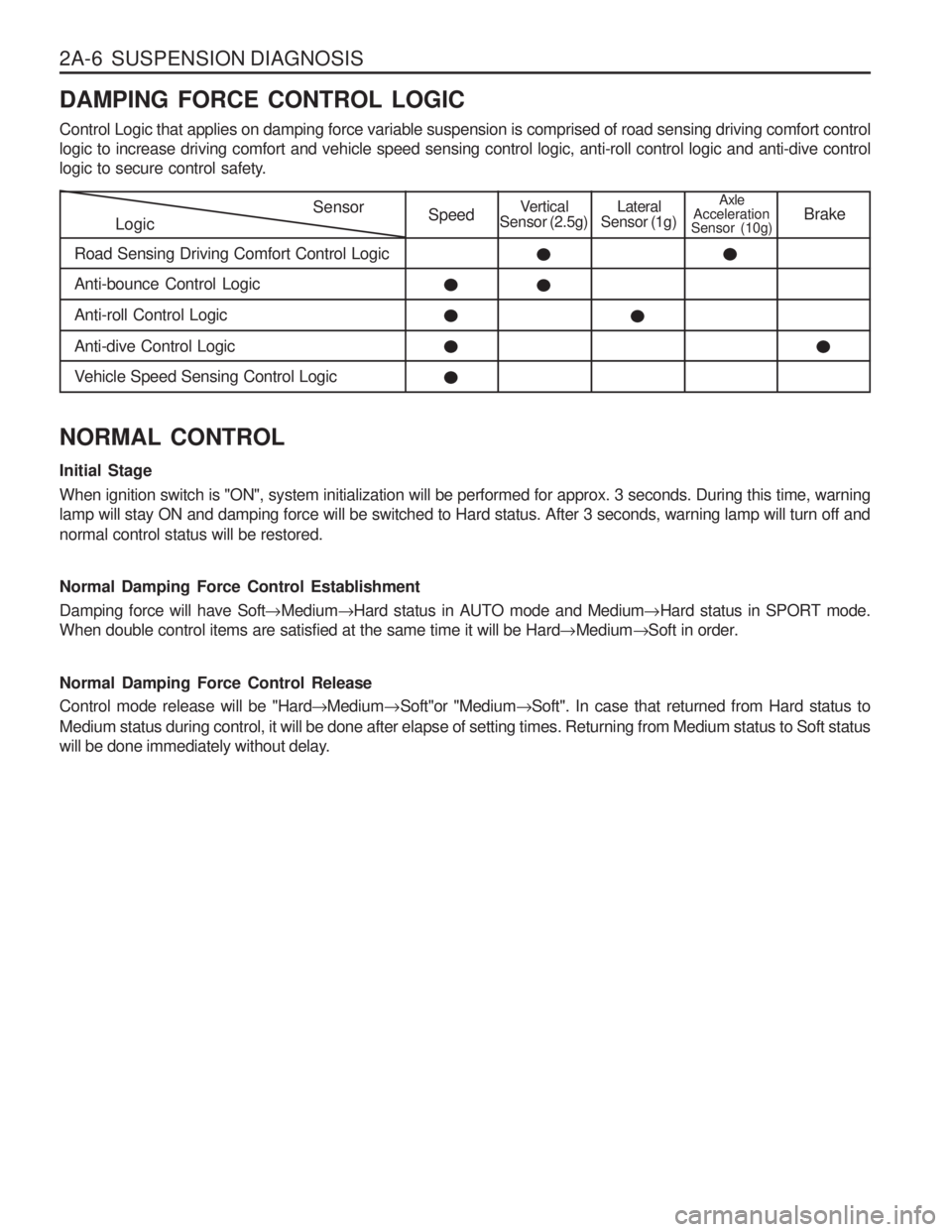
2A-6 SUSPENSION DIAGNOSIS DAMPING FORCE CONTROL LOGIC Control Logic that applies on damping force variable suspension is comprised of road sensing driving comfort control logic to increase driving comfort and vehicle speed sensing control logic, anti-roll control logic and anti-dive control
logic to secure control safety.
LogicSensor
Road Sensing Driving Comfort Control LogicSpeedVertical
Sensor (2.5g)Lateral
Sensor (1g)Axle
Acceleration
Sensor (10g) Brake
Anti-bounce Control Logic Anti-roll Control LogicAnti-dive Control Logic
Vehicle Speed Sensing Control Logic
NORMAL CONTROL Initial Stage When ignition switch is "ON", system initialization will be performed for approx. 3 seconds. During this time, warning lamp will stay ON and damping force will be switched to Hard status. After 3 seconds, warning lamp will turn off and normal control status will be restored. Normal Damping Force Control Establishment Damping force will have Soft �Medium �Hard status in AUTO mode and Medium �Hard status in SPORT mode.
When double control items are satisfied at the same time it will be Hard �Medium �Soft in order.
Normal Damping Force Control Release Control mode release will be "Hard �Medium �Soft"or "Medium �Soft". In case that returned from Hard status to
Medium status during control, it will be done after elapse of setting times. Returning from Medium status to Soft status
will be done immediately without delay.
Page 835 of 1574
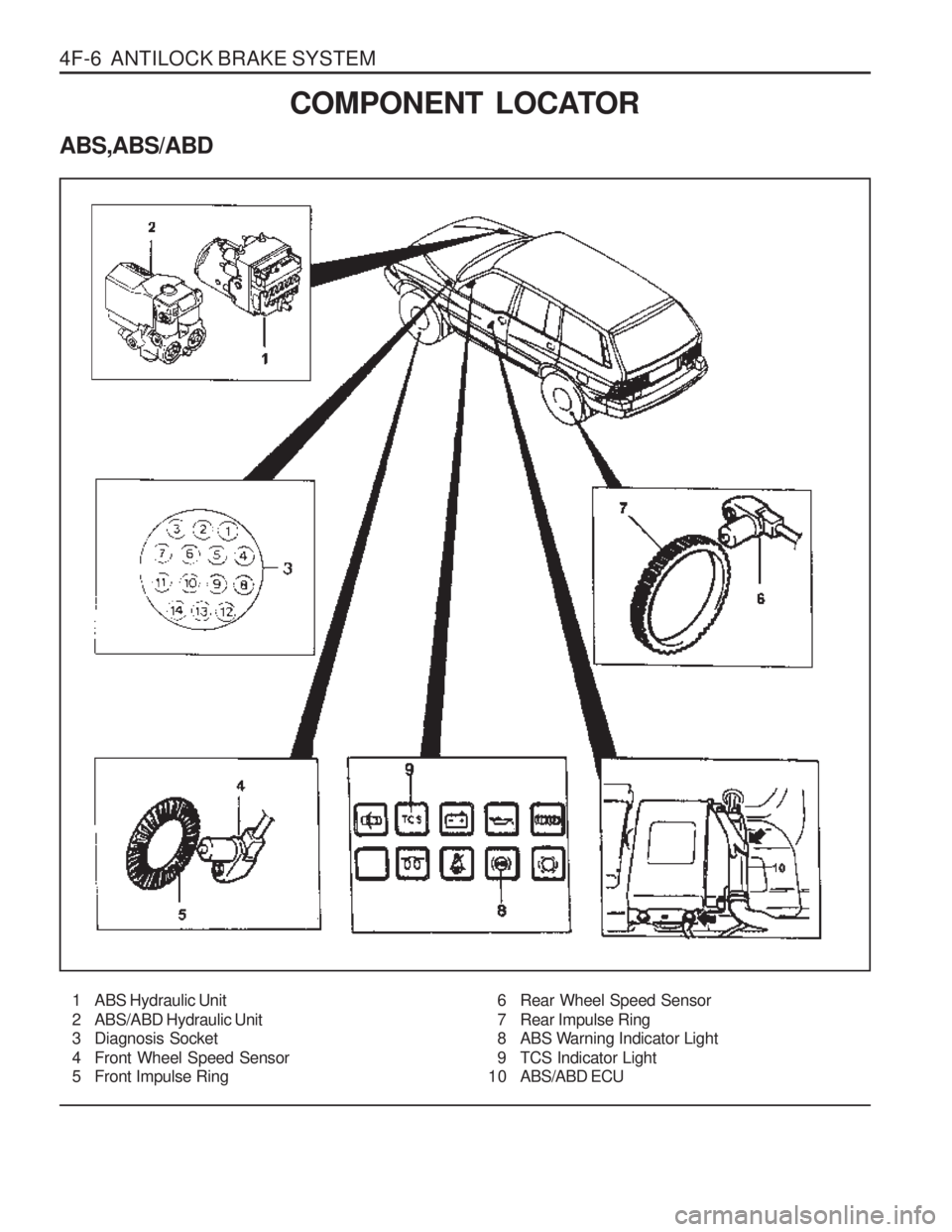
4F-6 ANTILOCK BRAKE SYSTEM
ABS,ABS/ABD
COMPONENT LOCATOR
1 ABS Hydraulic Unit
2 ABS/ABD Hydraulic Unit
3 Diagnosis Socket
4 Front Wheel Speed Sensor
5 Front Impulse Ring 6 Rear Wheel Speed Sensor
7 Rear Impulse Ring
8 ABS Warning Indicator Light
9 TCS Indicator Light
1 0 ABS/ABD ECU
Page 837 of 1574
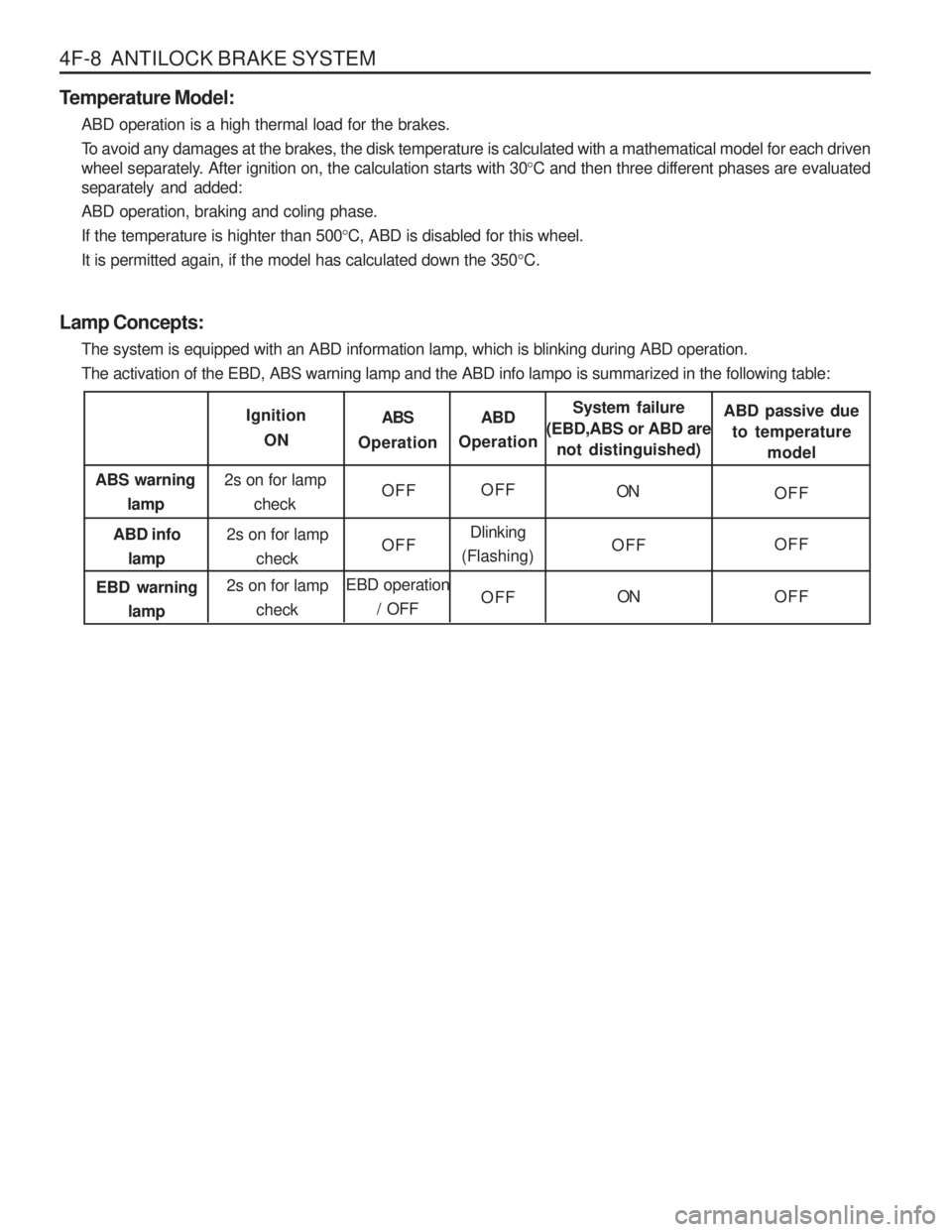
4F-8 ANTILOCK BRAKE SYSTEM
Temperature Model:ABD operation is a high thermal load for the brakes.
To avoid any damages at the brakes, the disk temperature is calculated with a mathematical model for each driven
wheel separately. After ignition on, the calculation starts with 30 °C and then three different phases are evaluated
separately and added: ABD operation, braking and coling phase.If the temperature is highter than 500 °C, ABD is disabled for this wheel.
It is permitted again, if the model has calculated down the 350 °C.
Lamp Concepts: The system is equipped with an ABD information lamp, which is blinking during ABD operation.The activation of the EBD, ABS warning lamp and the ABD info lampo is summarized in the following table:
IgnitionON ABS
Operation ABD
Operation System failure
(EBD,ABS or ABD are
not distinguished) ABD passive due
to temperature
model
ABS warning lamp
ABD info lamp
EBD warning lamp 2s on for lamp
check
2s on for lamp check
2s on for lamp check OFF
EBD operation / OFFOFF
OFF
Dlinking
(Flashing)
OFF ON
OFF ON OFF OFF OFF
Page 838 of 1574
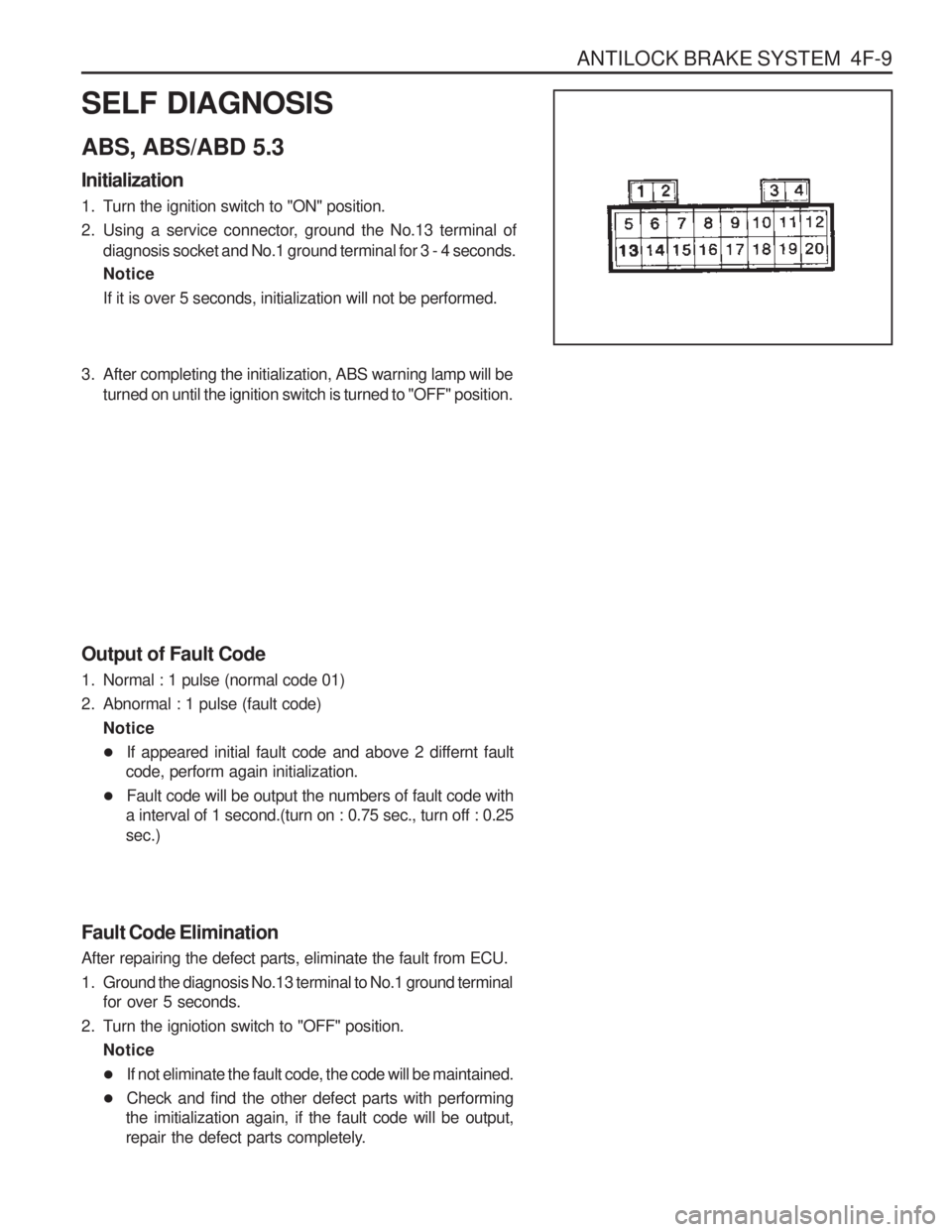
ANTILOCK BRAKE SYSTEM 4F-9
SELF DIAGNOSIS ABS, ABS/ABD 5.3 Initialization
1. Turn the ignition switch to "ON" position.
2. Using a service connector, ground the No.13 terminal ofdiagnosis socket and No.1 ground terminal for 3 - 4 seconds. Notice If it is over 5 seconds, initialization will not be performed.
3. After completing the initialization, ABS warning lamp will beturned on until the ignition switch is turned to "OFF" position.
Output of Fault Code
1. Normal : 1 pulse (normal code 01)
2. Abnormal : 1 pulse (fault code) Notice
� If appeared initial fault code and above 2 differnt fault
code, perform again initialization.
� Fault code will be output the numbers of fault code with
a interval of 1 second.(turn on : 0.75 sec., turn off : 0.25 sec.)
Fault Code Elimination After repairing the defect parts, eliminate the fault from ECU.
1. Ground the diagnosis No.13 terminal to No.1 ground terminal for over 5 seconds.
2. Turn the igniotion switch to "OFF" position. Notice
� If not eliminate the fault code, the code will be maintained.
� Check and find the other defect parts with performing
the imitialization again, if the fault code will be output,
repair the defect parts completely.
Page 840 of 1574
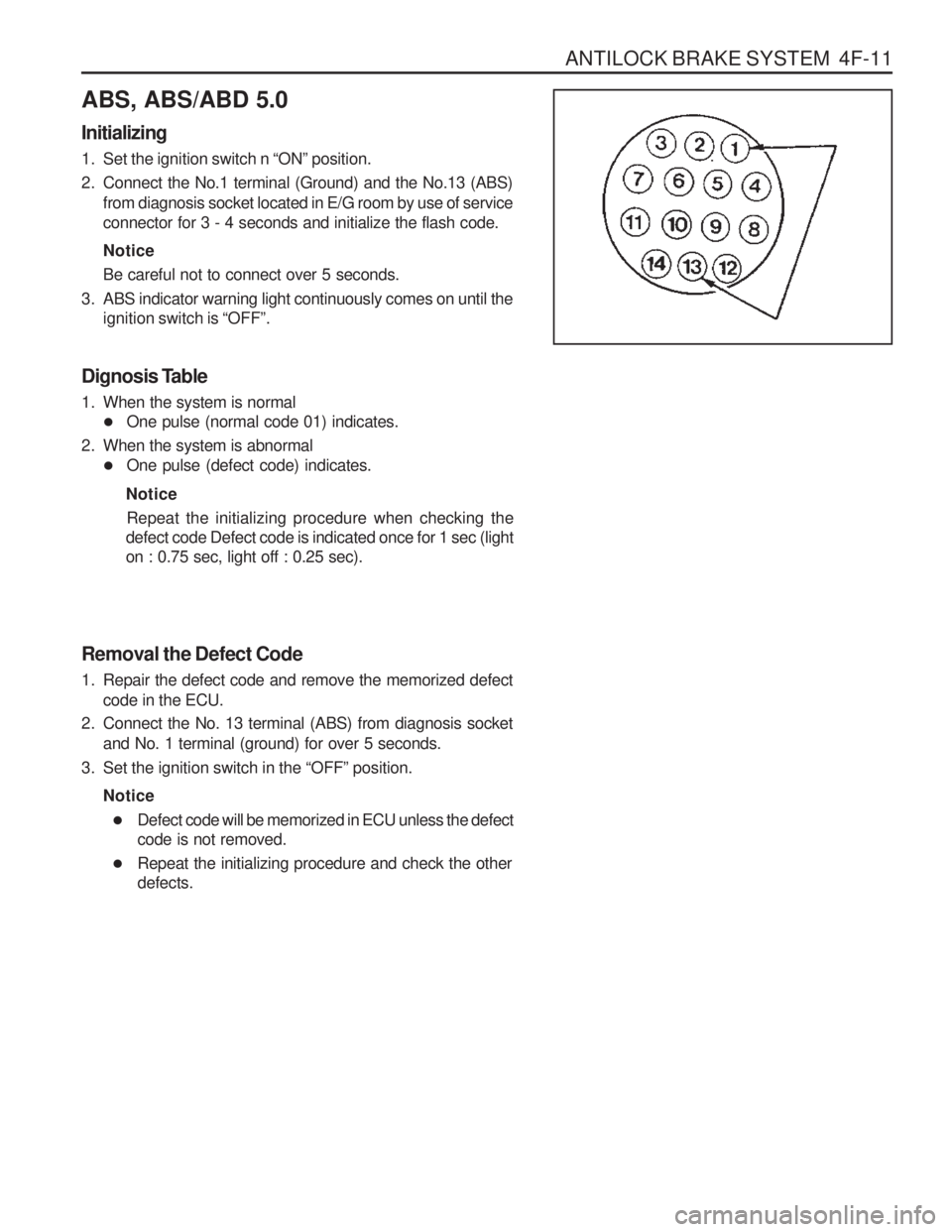
ANTILOCK BRAKE SYSTEM 4F-11
ABS, ABS/ABD 5.0 Initializing
1. Set the ignition switch n “ON ” position.
2. Connect the No.1 terminal (Ground) and the No.13 (ABS) from diagnosis socket located in E/G room by use of service connector for 3 - 4 seconds and initialize the flash code. Notice Be careful not to connect over 5 seconds.
3. ABS indicator warning light continuously comes on until the ignition switch is “OFF ”.
Dignosis Table
1. When the system is normal � One pulse (normal code 01) indicates.
2. When the system is abnormal � One pulse (defect code) indicates.
Notice Repeat the initializing procedure when checking the
defect code Defect code is indicated once for 1 sec (light on : 0.75 sec, light off : 0.25 sec).
Removal the Defect Code
1. Repair the defect code and remove the memorized defect code in the ECU.
2. Connect the No. 13 terminal (ABS) from diagnosis socket and No. 1 terminal (ground) for over 5 seconds.
3. Set the ignition switch in the “OFF ” position.
Notice � Defect code will be memorized in ECU unless the defect code is not removed.
� Repeat the initializing procedure and check the otherdefects.
Page 860 of 1574
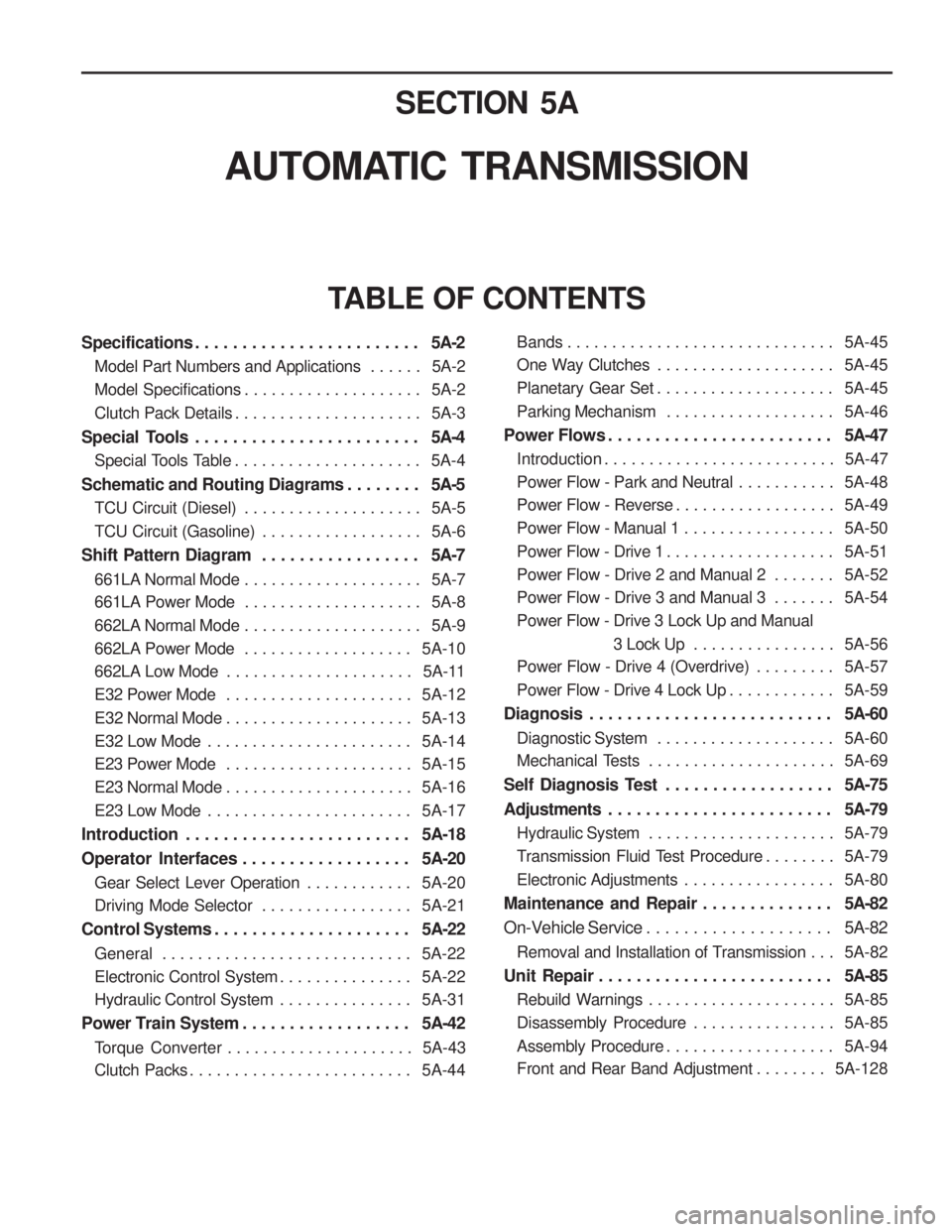
SECTION 5A
AUTOMATIC TRANSMISSION
TABLE OF CONTENTS
Specifications . . . . . . . . . . . . . . . . . . . . . . . . 5A-2
Model Part Numbers and Applications . . . . . . 5A-2
Model Specifications . . . . . . . . . . . . . . . . . . . . 5A-2
Clutch Pack Details . . . . . . . . . . . . . . . . . . . . . 5A-3
Special Tools . . . . . . . . . . . . . . . . . . . . . . . . 5A-4
Special Tools Table . . . . . . . . . . . . . . . . . . . . . 5A-4
Schematic and Routing Diagrams . . . . . . . . 5A-5
TCU Circuit (Diesel) . . . . . . . . . . . . . . . . . . . . 5A-5
TCU Circuit (Gasoline) . . . . . . . . . . . . . . . . . . 5A-6
Shift Pattern Diagram . . . . . . . . . . . . . . . . . 5A-7
661LA Normal Mode . . . . . . . . . . . . . . . . . . . . 5A-7
661LA Power Mode . . . . . . . . . . . . . . . . . . . . 5A-8
662LA Normal Mode . . . . . . . . . . . . . . . . . . . . 5A-9
662LA Power Mode . . . . . . . . . . . . . . . . . . . 5A-10
662LA Low Mode . . . . . . . . . . . . . . . . . . . . . 5A-11
E32 Power Mode . . . . . . . . . . . . . . . . . . . . . 5A-12
E32 Normal Mode . . . . . . . . . . . . . . . . . . . . . 5A-13
E32 Low Mode . . . . . . . . . . . . . . . . . . . . . . . 5A-14
E23 Power Mode . . . . . . . . . . . . . . . . . . . . . 5A-15
E23 Normal Mode . . . . . . . . . . . . . . . . . . . . . 5A-16
E23 Low Mode . . . . . . . . . . . . . . . . . . . . . . . 5A-17
Introduction . . . . . . . . . . . . . . . . . . . . . . . . 5A-18
Operator Interfaces . . . . . . . . . . . . . . . . . . 5A-20
Gear Select Lever Operation . . . . . . . . . . . . 5A-20
Driving Mode Selector . . . . . . . . . . . . . . . . . 5A-21
Control Systems . . . . . . . . . . . . . . . . . . . . . 5A-22
General . . . . . . . . . . . . . . . . . . . . . . . . . . . . 5A-22
Electronic Control System . . . . . . . . . . . . . . . 5A-22
Hydraulic Control System . . . . . . . . . . . . . . . 5A-31
Power Train System . . . . . . . . . . . . . . . . . . 5A-42
Torque Converter . . . . . . . . . . . . . . . . . . . . . 5A-43
Clutch Packs . . . . . . . . . . . . . . . . . . . . . . . . . 5A-44Bands . . . . . . . . . . . . . . . . . . . . . . . . . . . . . . 5A-45
One Way Clutches . . . . . . . . . . . . . . . . . . . .
5A-45
Planetary Gear Set . . . . . . . . . . . . . . . . . . . . 5A-45
Parking Mechanism . . . . . . . . . . . . . . . . . . . 5A-46
Power Flows . . . . . . . . . . . . . . . . . . . . . . . . 5A-47
Introduction . . . . . . . . . . . . . . . . . . . . . . . . . . 5A-47
Power Flow - Park and Neutral . . . . . . . . . . . 5A-48
Power Flow - Reverse . . . . . . . . . . . . . . . . . . 5A-49
Power Flow - Manual 1 . . . . . . . . . . . . . . . . . 5A-50
Power Flow - Drive 1 . . . . . . . . . . . . . . . . . . . 5A-51
Power Flow - Drive 2 and Manual 2 . . . . . . . 5A-52
Power Flow - Drive 3 and Manual 3 . . . . . . . 5A-54
Power Flow - Drive 3 Lock Up and Manual
3 Lock Up . . . . . . . . . . . . . . . . 5A-56
Power Flow - Drive 4 (Overdrive) . . . . . . . . . 5A-57
Power Flow - Drive 4 Lock Up . . . . . . . . . . . . 5A-59
Diagnosis . . . . . . . . . . . . . . . . . . . . . . . . . . 5A-60
Diagnostic System . . . . . . . . . . . . . . . . . . . . 5A-60
Mechanical Tests . . . . . . . . . . . . . . . . . . . . . 5A-69
Self Diagnosis Test . . . . . . . . . . . . . . . . . . 5A-75
Adjustments . . . . . . . . . . . . . . . . . . . . . . . . 5A-79
Hydraulic System . . . . . . . . . . . . . . . . . . . . . 5A-79
Transmission Fluid Test Procedure . . . . . . . . 5A-79
Electronic Adjustments . . . . . . . . . . . . . . . . . 5A-80
Maintenance and Repair . . . . . . . . . . . . . . 5A-82
On-Vehicle Service . . . . . . . . . . . . . . . . . . . . 5A-82
Removal and Installation of Transmission . . . 5A-82
Unit Repair . . . . . . . . . . . . . . . . . . . . . . . . . 5A-85
Rebuild Warnings . . . . . . . . . . . . . . . . . . . . . 5A-85
Disassembly Procedure . . . . . . . . . . . . . . . . 5A-85
Assembly Procedure . . . . . . . . . . . . . . . . . . . 5A-94
Front and Rear Band Adjustment . . . . . . . . 5A-128
Page 944 of 1574
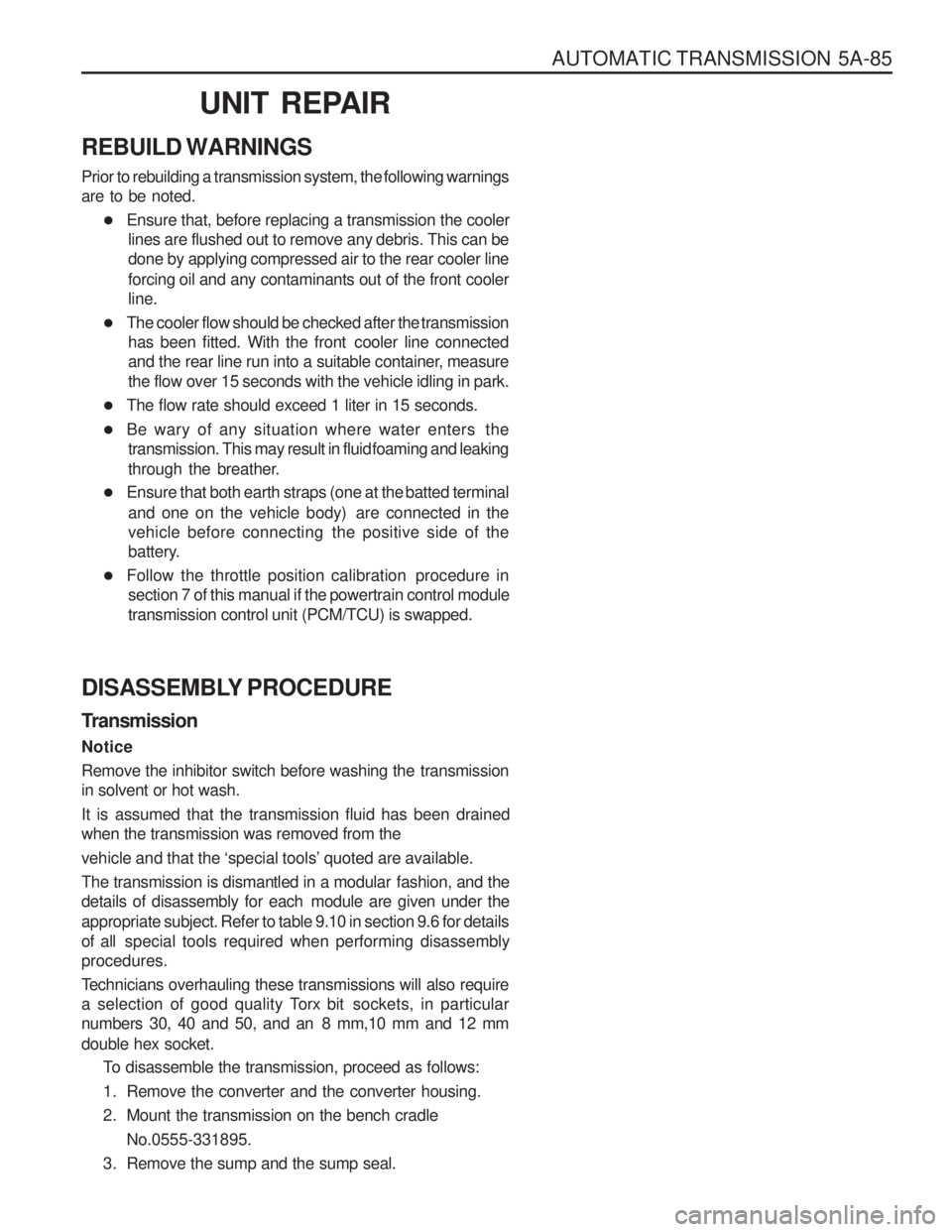
AUTOMATIC TRANSMISSION 5A-85
UNIT REPAIR
REBUILD WARNINGS
Prior to rebuilding a transmission system, the following warnings are to be noted. � Ensure that, before replacing a transmission the cooler
lines are flushed out to remove any debris. This can be
done by applying compressed air to the rear cooler line
forcing oil and any contaminants out of the front cooler line.
� The cooler flow should be checked after the transmission
has been fitted. With the front cooler line connected
and the rear line run into a suitable container, measure
the flow over 15 seconds with the vehicle idling in park.
� The flow rate should exceed 1 liter in 15 seconds.
� Be wary of any situation where water enters the
transmission. This may result in fluid foaming and leaking
through the breather.
� Ensure that both earth straps (one at the batted terminal
and one on the vehicle body) are connected in the
vehicle before connecting the positive side of the
battery.
� Follow the throttle position calibration procedure in
section 7 of this manual if the powertrain control module
transmission control unit (PCM/TCU) is swapped.
DISASSEMBLY PROCEDURE
Transmission Notice
Remove the inhibitor switch before washing the transmission in solvent or hot wash.
It is assumed that the transmission fluid has been drained when the transmission was removed from the vehicle and that the ‘special tools ’ quoted are available.
The transmission is dismantled in a modular fashion, and the
details of disassembly for each module are given under the
appropriate subject. Refer to table 9.10 in section 9.6 for details
of all sp ecial tools required when performing disassembly
procedures.
Technicians overhauling these transmissions will also require a selection of good quality T orx bit sockets, in particular
numbers 30, 40 and 50, and an 8 mm,10 mm and 12 mm double hex socket.
To disassemble the transmission, proceed as follows:
1. Remove the converter and the converter housing.
2. Mount the transmission on the bench cradle
No.0555-331895.
3. Remove the sump and the sump seal.
Page 1177 of 1574
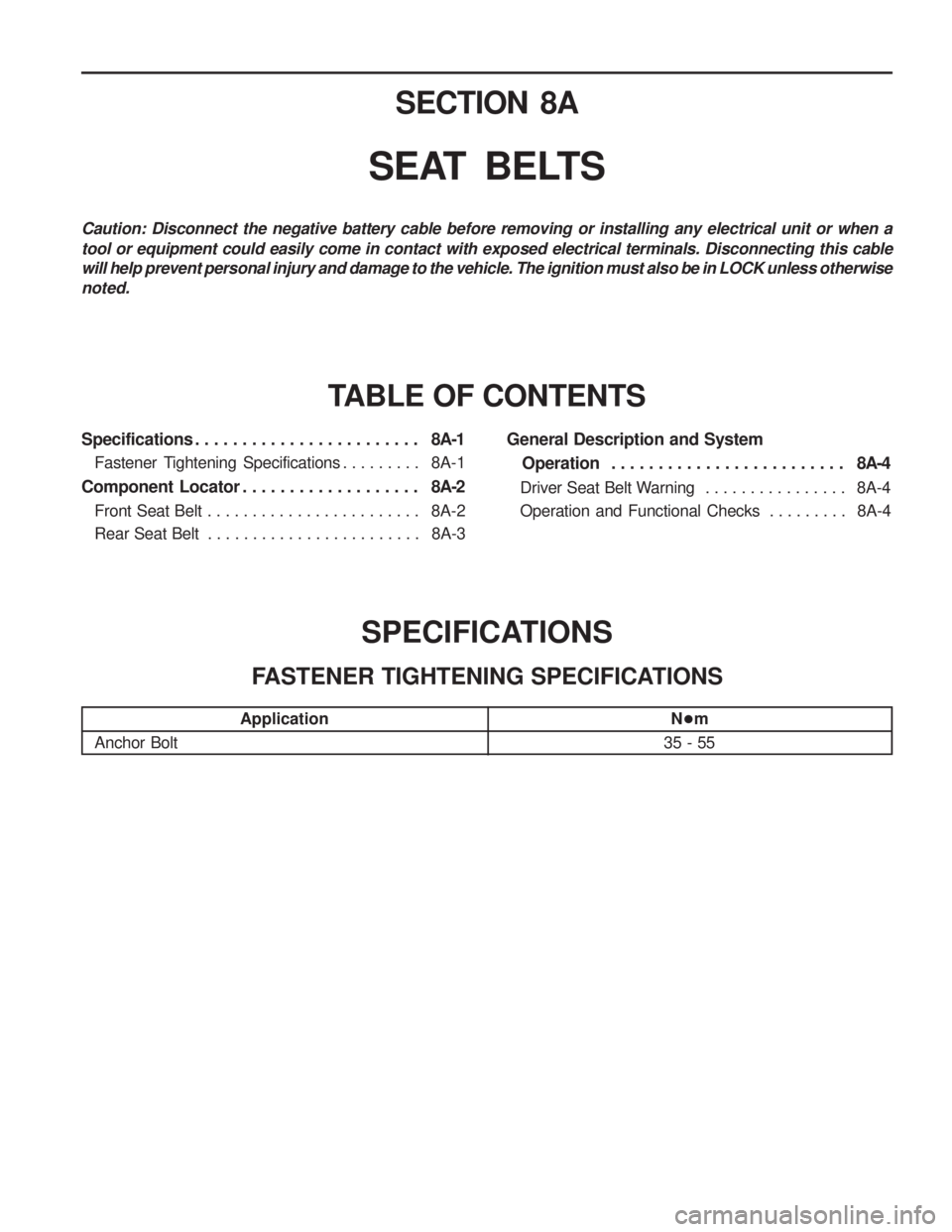
SECTION 8A
SEAT BELTS
Specifications . . . . . . . . . . . . . . . . . . . . . . . . 8A-1
Fastener Tightening Specifications . . . . . . . . . 8A-1
Component Locator . . . . . . . . . . . . . . . . . . . 8A-2
Front Seat Belt . . . . . . . . . . . . . . . . . . . . . . . . 8A-2
Rear Seat Belt . . . . . . . . . . . . . . . . . . . . . . . . 8A-3 TABLE OF CONTENTS
Caution: Disconnect the negative battery cable before removing or installing any electrical unit or when a tool or equipment could easily come in contact with exposed electrical terminals. Disconnecting this cable will help prevent personal injury and damage to the vehicle. The ignition must also be in LOCK unless otherwisenoted.
General Description and System
Operation . . . . . . . . . . . . . . . . . . . . . . . . . 8A-4
Driver Seat Belt Warning . . . . . . . . . . . . . . . . 8A-4
Operation and Functional Checks . . . . . . . . . 8A-4
SPECIFICATIONS
FASTENER TIGHTENING SPECIFICATIONS
Application
Anchor Bolt N
�m
35 - 55
Page 1180 of 1574
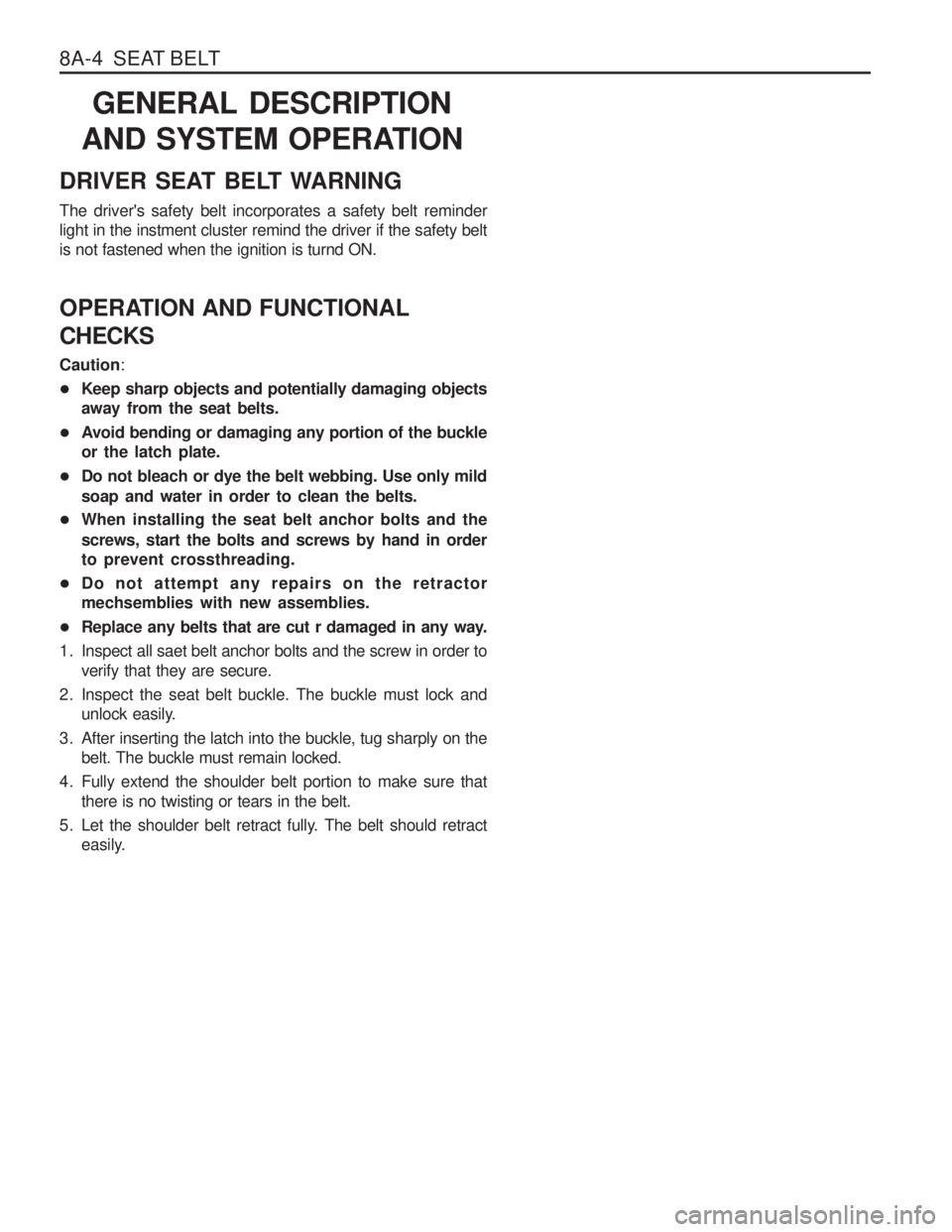
8A-4 SEAT BELTGENERAL DESCRIPTION
AND SYSTEM OPERATION
DRIVER SEAT BELT WARNING The driver's safety belt incorporates a safety belt reminder light in the instment cluster remind the driver if the safety beltis not fastened when the ignition is turnd ON.
OPERATION AND FUNCTIONAL CHECKS Caution :
� Keep sharp objects and potentially damaging objects away from the seat belts.
� Avoid bending or damaging any portion of the buckleor the latch plate.
� Do not bleach or dye the belt webbing. Use only mild soap and water in order to clean the belts.
� When installing the seat belt anchor bolts and thescrews, start the bolts and screws by hand in order to prevent crossthreading.
� Do not attempt any repairs on the retractormechsemblies with new assemblies.
� Replace any belts that are cut r damaged in any way.
1. Inspect all saet belt anchor bolts and the screw in order to verify that they are secure.
2. Inspect the seat belt buckle. The buckle must lock and unlock easily.
3. After inserting the latch into the buckle, tug sharply on the belt. The buckle must remain locked.
4. Fully extend the shoulder belt portion to make sure that there is no twisting or tears in the belt.
5. Let the shoulder belt retract fully. The belt should retract easily.